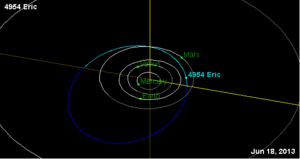4954 Eric
|
Orbit diagram of 4954 Eric with location of object on June 18, 2013 | |
| Discovery | |
|---|---|
| Discovery date | September 23, 1990 |
| Orbital characteristics | |
| Aphelion | 2.8998 AU |
| Perihelion | 1.10325 AU |
| 2.0015 AU | |
| Eccentricity | 0.44879 |
| 2.83 yr | |
| Inclination | 17.4465 deg |
| Physical characteristics | |
| Dimensions | 10.8 km |
| 12.052[1] hours | |
Spectral type | B-type asteroid[2] |
| 12.6 | |
|
| |
4954 Eric is an Amor asteroid with a diameter of 10.8 km that was discovered by American astronomer Brian P. Roman on 1990 September 23.[3] It was named after its discoverer's son, Eric Roman. The asteroid has a rotation period of 12.05 hours.[1]
It is the largest near-Earth asteroid discovered since 3552 Don Quixote in 1983.[4] On 2007 October 11 the asteroid passed 0.2865 AU (42,860,000 km; 26,630,000 mi) from Earth.[3] It currently makes closer approaches to Mars than it does Earth.
Other large near-Earth asteroids include: 1036 Ganymed (32 km), 3552 Don Quixote (19 km), 433 Eros (17 km), and 1866 Sisyphus (8.5 km).[4][5]
References
- ↑ 1.0 1.1 Hanuš, J. et al. (March 2013), "Asteroids' physical models from combined dense and sparse photometry and scaling of the YORP effect by the observed obliquity distribution", Astronomy & Astrophysics 551: A67, arXiv:1301.6943, Bibcode:2013A&A...551A..67H, doi:10.1051/0004-6361/201220701.
- ↑ based on a high-resolution spectrum by Xu et al. (1995) or Bus and Binzel (2002)
- ↑ 3.0 3.1 "JPL Close-Approach Data: 4954 Eric (1990 SQ)" (2012-09-04 last obs). Retrieved 2013-10-30.
- ↑ 4.0 4.1 "JPL Small-Body Database Search Engine: asteroids and NEOs and H < 13 (mag)". JPL Solar System Dynamics. Retrieved 2013-04-11.
- ↑ N. McBride and I. Gilmour - An Introduction to the Solar System (2004) - Page 394
| ||||||
| ||||||||||||||||||||||||||||
